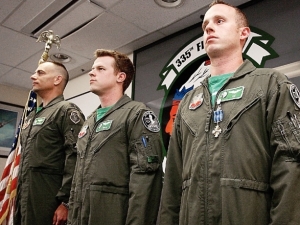Two members of 335th Fighter Squadron receive Distinguished Flying Cross
By Kenneth Fine
Published in News on April 13, 2010 1:46 PM

News-Argus/MICHAEL BETTS
335th Fighter Squadron Capt. Mike Polidor, right, and 1st Lt. Aaron Dove, center, were recently awarded the coveted Distinguished Flying Cross by their squadron commander, Lt. Col. Chris Anthony, during a ceremony at Seymour Johnson Air Force Base.
It should have been a successful ambush -- some 250 insurgents surrounding an 80-man Coalition outpost tucked deep in one of the many valleys scattered across Afghanistan.
But when a troops-in-contact call reached the cockpit of an F-15E Strike Eagle parked on the Bagram Airfield runway, the odds quickly changed.
"Normally, when they tell you, 'Go somewhere right now,' they say, 'Go to this place ... contact this controller on this frequency, this air space.' They give you a lot of these other details," said Capt. Mike Polidor, the 335th Fighter Squadron pilot on the receiving end of that call. "We didn't get any of that. It was, '(Combat Observation Post) Keating is being overrun. You need to go there right now.' ... So we took off and just pointed in that general direction."
Less than 10 minutes later, Polidor and his weapon systems officer, 1st Lt. Aaron Dove, engaged in what would be a seven-hour assault on those who had infiltrated the wire.
And for their leadership role in an air power campaign that included five other 4th Fighter Wing Strike Eagles, two AH-64 Apache helicopters, four A-10 Thunderbolt IIs, a B-1 bomber and numerous unmanned aircraft -- an effort that resulted in 31,500 pounds of ordnance employed and 72 lives saved -- the crew was recently awarded the coveted Distinguished Flying Cross.
*
Polidor and Dove had just gone through their routine pre-flight maintenance check and were preparing for a typical sortie -- which, in Afghanistan, could mean anything from responding to troops-in-contact calls to escorting convoys -- when they were told to launch.
But it wasn't until moments later, when they approached Kamdesh Valley, that the severity of the situation set in.
"Looking outside, the whole valley ... was full of smoke," Dove said. "You could just see a couple Apaches down there ... and basically, anything left standing was on fire. ... It was pretty chaotic."
And the two 335th Strike Eagles already at the scene were running low on fuel.
Polidor and Dove knew they couldn't waste any time -- not with lives at stake.
"(All three radios), they were all going absolutely crazy," Polidor said. "People were just yelling and screaming, 'We need weapons now.'"
And even though both the captain and his WSO would say any 335th crew would have done the same, when they, moments later, took charge of the support effort, the officers helped ensure the majority of those ambushed at COP Keating saw another day.
They made contact with the two Apaches to get a better feel for what was happening on the ground -- the locations of both the friendly and enemy forces, where to drop bombs and to unload rounds of strafe.
And then, along with the other aircraft that joined the counter-insurgency effort, they engaged.
"We were there until nightfall," Polidor said. "We were the ones who had the most information about what was going on ... and I guess, by default, we kind of took over."
*
The events that unfolded Oct. 3 will stay with Polidor and Dove forever.
For Dove, the intensity of the situation was heightened by the fact that he had only been declared "mission-ready" a few months before that sortie.
"I guess you could call it a baptism by fire," he said. "It was definitely an eye-opener."
And for Polidor, a more seasoned combat aviator who already had a deployment under his belt before the 335th's latest stint in Afghanistan, the sights and sounds he will associate with COP Keating for the rest of his life stand out.
"It was pandemonium," he said. "It was by far, absolutely the most intense (combat sortie I have ever flown)."
But don't call these officers heroes.
At least not unless you are ready to hear about the others who were in the air that day -- and, more importantly, those on the ground -- some of whom made the ultimate sacrifice.
"(The guys on the ground) were doing their jobs that day and we were just doing ours," Polidor said. "We were just the ones who happened to be there. I'm sure if it had been anyone else in the squadron, the outcome would have been the same."
Dove agreed.
"Our mission over there is support for all those guys on the ground," he said. "Every time you walk out to the jet, there's a sign on the door that says, 'The mission is an 18-year-old with a rifle. Everything else is support.' That pretty much sums it up."
